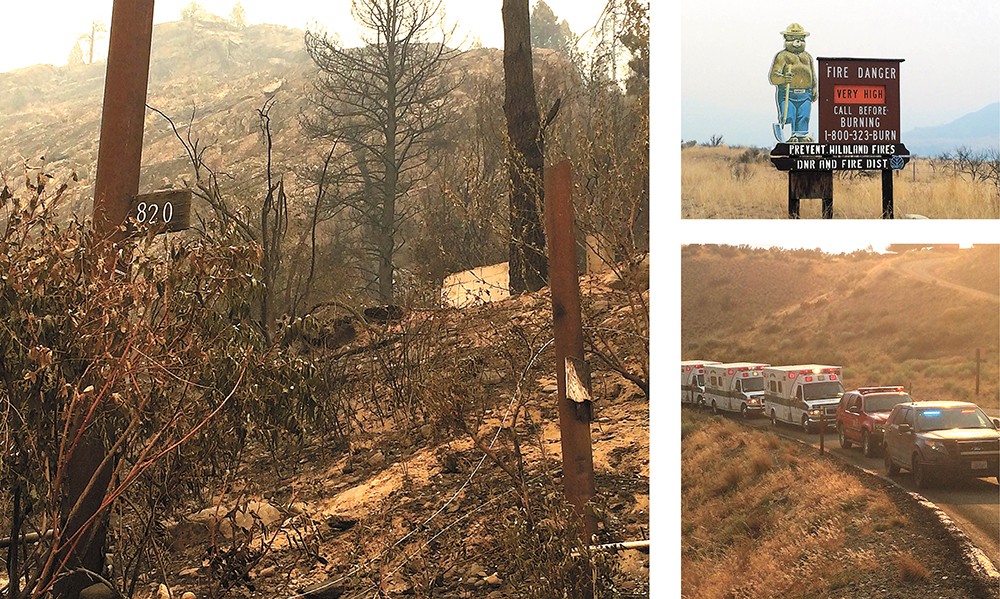
The smoke is so thick in Pateros, Washington, it feels like a scratchy wool blanket wrapped around you on a cold winter night. It's choking and stings the eyes.
Carol Hamshaw stands in front of what used to be her house, still smoldering. Around it, 15 other houses have burned. She speaks breathlessly, wiping away tears, pausing to hug a friend who came to comfort her. The emotion in her voice is real and raw.
"In Chelan they don't let houses burn down," she says.
Hamshaw, who previously lived 20 miles away in Chelan, had evacuated to there the night the fire swept through. This was July 18, 2014, the morning after the Carlton Complex fire hit Pateros and devastated the small town at the confluence of the Methow and Columbia rivers. The Carlton fire would eventually destroy nearly 300 homes and burn more than 250,000 acres. At the time that made it the largest managed wildfire in Washington state history.
That is, until this year.
Fast-forward 13 months and the situation is eerily similar, yet simultaneously much different. Pateros is still filled with smoke (like much of the Northwest), but this year as fires again burn relentlessly in the region, it's not Pateros that needs help. As fires spread fast last week up the Methow Valley near Twisp and east into the heart of Okanogan County and the Colville Indian Reservation, it was Pateros and its riverside hotel and restaurant where people evacuated to.
Unlike Hamshaw's emotional and in-the-moment words in the hours after her house went up in flames last year, houses this year have indeed burned in Chelan. And across the river in Douglas County. And in Okanogan County. And at least 50 in the Clearwater fire in Idaho. And at least 26 in Oregon's Canyon Creek Complex.
The situation in Washington led Gov. Jay Inslee to ask for a federal disaster declaration last week to make more resources available, which President Obama granted.
Welcome to 2015, the Summer of Northwest Burn.
'No relief in sight'
"Stretched thin" is a term thrown around in seemingly every news report about fires this year. It applies not just to firefighting resources like pumper trucks and helicopters, but to fire personnel and less noticeable items like hygiene. The fire camp for the Okanogan Complex, which in the past week became the top-priority fire in the country and has surpassed the 2014 Carlton Complex in size, had only one mobile shower truck for more than 1,000 people.
"Every other shower trailer is spoken for on another [fire] incident somewhere across the Northwest," says Dan Omdal, a public information officer for the Okanogan Complex. "That's not enough showers to handle this."
The central food operation, which is staffed by inmates in a work-release program, is feeding all those mouths with the same size crew and facility they had when the camp housed only 400 people earlier in August. There are so many people to feed with so little cooking space, it's become necessary to assign shifts for eating.
Though the nearby North Star fire on the Colville Indian Reservation is geographically in Okanogan County, it's not managed as part of the larger Okanogan Complex. There are several reasons for that, some to do with geography, and others with division of responsibility and bureaucracy. The Colville Confederated Tribes has its own wildland firefighting operation for the 1.4 million-acre reservation. Federal management is automatically involved with fires on the reservation due to the presence of the federal Bureau of Indian Affairs.
But the number of resources given to other fires like the Chelan and Okanogan Complexes — not to mention wide attention from news media — have drawn criticism from those who question why the North Star fire hasn't received more.
Ted Piccolo is among those questioning fire priorities. He believes that the value of timber on reservation forest land should be a top priority to defend from fire because it's a way the tribe makes money. By extension, in his view, it's a way of life and economic engine for Colville members, who depend on timber sales for income.
"It's a sad thing to see the foundations of a burnt-out home on the banks of Lake Chelan on the nightly news," Piccolo writes on Facebook. "However I argue that what is sadder are the burnt out invisible foundations that have been our way of life on the Colville Indian Reservation coupled with generational economic loss."
Like other fires late last week, the North Star spread far and grew fast Thursday and Friday because of strong winds, and had grown to 147,000 acres by Monday, with 3 percent contained and an estimated 2,000 structures threatened.
Fire managers reported that no structures were known to have burned, but even so, the official fire incident report early this week offered a blunt assessment:
"Fire will remain very active due to continued warm and dry with critically dry fuels," said the report. "No relief in sight... "
Suppression vs. protection
The back-and-forth between which fires deserve which resources is rehashing an old debate about not only how to fight wildfires, but why. The aggressive suppression strategy of the past — putting out forest fires fast no matter how remote — has generally changed to focus first and foremost on public safety and structure protection, says Omdal, who also is a forest pathologist for the Washington Department of Natural Resources.
That, he says, explains partially how federal and state authorities determine how to prioritize fires, along with factors like total number of houses threatened and potential for growth.
"These decisions are not made in insolation," Omdal says, noting that there are a lot of people and other fire management teams involved in assessing how to prioritize any particular fire.
Even with the shifting focus on how to prioritize fires, events like the Aug. 19 deaths of three firefighters in Twisp placed renewed attention and scrutiny on fire management, just as a similar incident on a nearby fire did 14 years ago.
On July 10, 2001, four firefighters were killed on the Thirtymile fire north of Twisp, prompting multiple investigations, a book, congressional action on how fires are managed, and the first criminal charges ever against a fire manager.
"Things [in fighting forest fire] very much changed from a command perspective [after Thirtymile]," says Jarred Johnson, who fought the fire in 2001 but didn't know the crew who died. As a former firefighter who now lives in Twisp, he was watching the current fire burning there the day after Tom Zbyszewski, Andrew Zajac and Richard Wheeler died.
But, Johnson says, as far as forest and ecological management go in preventing and lessening the impact of large-scale wildfires, "We're still making the same mistakes."
Living in fire (or at least smoke)
With back-to-back years of large fires that burn numerous homes, it's natural to ask if things are getting worse. And what's the cause? You'll hear different explanations (and places to put blame) depending on who you ask: It's the severe drought. It's climate change. It's because of forest management practices from 30 years ago catching up with us. It's all the beetle-killed trees in timber land. It's because Congress cut this or that budget. It's because people live further out in the country in fire-prone areas. And so on.
As Omdal, the forest pathologist, says in science- and government-speak, being careful not to attribute to any cause or assign blame: "It's multi-factorial."
Scientists, government agencies, elected officials, environmental advocacy groups and anyone with an opinion will continue the back-and-forth. But that doesn't change the short-term situation for those living in fire-prone regions.
The sentiment from numerous people in the region over the past week — those who evacuated this year and in the past — was overwhelmingly accepting. Several people said similar things along the lines of: We're used to it. That's the way of life in this part of the state.
Colette Veneziani moved to Twisp in July to be near her parents and to have a slower pace of life.
"I had to escape the rat race," she says, noting that compared to city life and traffic in Seattle, the fires and evacuation notices currently going on are merely "an inconvenience."
Tory DeSalvo takes a similar tone. Last week she was sitting outside a Wenatchee Starbucks watching her young child and dog, having evacuated from Twisp with her husband the night before. She's lived in the Methow Valley for 15 years and is no stranger to fire danger and summer smoke.
But, she says, the reasons to stay in the region far outweigh the risk and costs.
"We all live here because of the tight community," DeSalvo says. "You can't burn that down." ♦



















